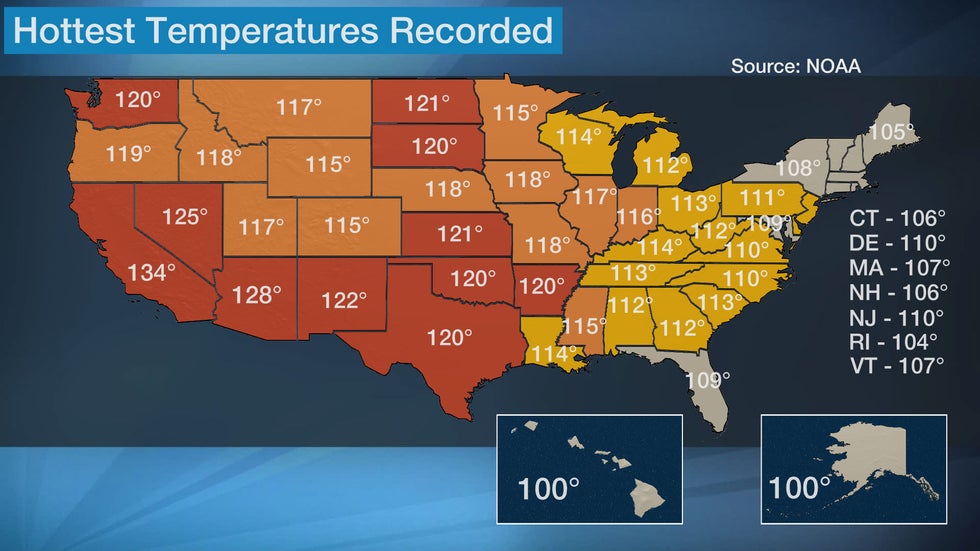Explore The Hottest State: US Extreme Heat In Death Valley!
Is there a place in the United States where the sun feels perpetually closer, where the air shimmers with heat haze, and where survival feels like a daily accomplishment? Yes, it's Death Valley, California, a land that doesn't just flirt with extreme temperatures it embraces them with a fervor that has cemented its place in weather history, boasting the highest temperature ever reliably recorded in the US: a staggering 134F (56.7C).
Death Valley, California, reigns supreme as the hottest locale in the United States, a reputation earned through its consistently scorching conditions. The average temperature here hovers around a sweltering 91F (33C), while the average high climbs to an even more intense 106F (41C). Adding insult to injury, Death Valley also holds the title of driest place in the nation, receiving a mere 2 inches (5 cm) of rainfall annually. This relentless combination of heat and aridity renders Death Valley a harsh and unforgiving environment, sparsely populated by only the most resilient inhabitants.
The inferno that is Death Valley is not simply a matter of chance; it's a meticulously crafted meteorological masterpiece. A confluence of factors, including its unique location, dramatic topography, and punishing climate, conspires to create this extreme heat. Nestled within the Mojave Desert, Death Valley resides in a rain shadow. This geographical phenomenon occurs when mountains intercept moisture-laden air masses, forcing them to release their precipitation on the windward side, leaving the leeward side in this case, Death Valley parched and dry. Furthermore, the valley's bowl-like shape, cradled by towering mountains, acts as a heat trap, preventing the escape of warm air and exacerbating the already brutal temperatures. Adding to this fiery equation, the arid climate of Death Valley provides little opportunity for evaporative cooling, leaving the air stagnant and intensely hot.
The oppressive heat in Death Valley poses significant risks, demanding vigilance and preparedness from anyone who ventures into its domain. To mitigate the dangers, it's crucial to prioritize hydration by drinking copious amounts of water. Wearing loose-fitting, light-colored clothing can help to promote airflow and reduce heat absorption. Finally, it's imperative to avoid strenuous activities during the peak heat hours, seeking shade and rest whenever possible to prevent heat-related illnesses.
| Category | Details |
|---|---|
| Name | Death Valley |
| Location | Mojave Desert, Eastern California, near Nevada border |
| Size | Approximately 3.3 million acres (1.3 million hectares) |
| Elevation | Lowest point: Badwater Basin - 282 feet (86 meters) below sea level |
| Mountains | Surrounded by Panamint Mountains (West), Grapevine Mountains (East), Amargosa Range (North) |
| Climate Type | Desert climate - hot summers, mild winters |
| Average Temperature | 91F (33C) |
| Average High Temperature | 106F (41C) |
| Annual Rainfall | Approximately 2 inches (5 cm) - driest place in the US |
| Humidity | Very low, typically around 10% |
| Flora | Cacti, Creosote bushes, Joshua trees, desert-adapted plants |
| Fauna | Coyotes, Bobcats, Jackrabbits, Lizards, desert-adapted animals |
| Conservation Status | Protected area with endangered species (Desert Tortoise, Mojave Ground Squirrel) |
| Website | National Park Service - Death Valley |
- What Happened Erin Olash Onlyfans Leak Scandal Explained Aftermath
- Who Is Sophie Aspin A Deep Dive Into Nudostars Life Impact

The Hottest Temperatures Recorded In All 50 States Weather Underground

Hottest States in the US 2024 (Month by Month) Suburbs 101

U.S. Hottest Days Map Wondering Maps